by Pat Hall
Bullfighting is a deeply controversial spectacle. It is called a "fine art" by its supporters and a "blood sport" by its critics. It takes place in Spain, France, Portugal, Mexico, Colombia, Venezuela, Peru, and Ecuador. The spectacle takes place inside a bullring. The bulls are baited before being killed according to formal rules and customs, which are interpreted by the bullfighter.
Bullfighting has been going on for thousands of years. It has come under inceasing critical pressure in recent decades, as the animal rights movement has grown. The opponents of the bullfight say that it is barbaric, a medieval relic which has no place in the modern world. They say that bullfighting is essentially torturing an animal purely for entertainment. As an animal lover, I had always agreed with bullfighting's critics.
One Sunday afternoon, when I was 30 years old, when my parents and I were in Mexico City, my father talked me into attending a bullfight. It took some talking, because I didn't want to go to such a horrible, cruel event. But, feeling sorry for my father because no one else would go with him, I finally agreed. I spent most of my time in the arena looking up, admiring the blue sky and watching planes come in for a landing at the international airport − anything other than looking down into the blood and gore of the actual bullfight going on in the ring.
One thing that struck me that afternoon was how much Mexicans love and enjoy bullfights. The gentle, kind, normal people that I knew cheered and chanted and thoroughly delighted in the whole process. I couldn't understand how these wonderful people could take such great pleasure in this gruesome event. So I started to do some research on bullfights. Because I worked in the university library at the Universidad de las Américas in Cholula, Puebla, it was easy to discover some amazing facts about the subject.
That was a great time of my life. Most weekends, while I was working at the library, I would go into Mexico City. It was only about a half hour drive from where I lived in Cholula, and the attractions of Mexico City were many. With some women my age I befriended there, I would go shopping for stylish clothing and partying it up in the amazing discotheques. One day two other Canadian women who worked in Mexico City and I got into a taxi. A new city law required that taxi drivers had to use a meter and, if they didn't, the passengers who hired them didn't have to pay. Well, we noticed that this driver hadn't started his meter so, when we reached our destination, we pointed out this infraction and told him that we wouldn't pay. Of course, we said this in fluent Spanish. We left him sitting there in his taxi in shock. No doubt he had been thinking that we had just got off a plane from the U.S.
Meanwhile, in order to determine whether my research was valid, I felt the need to attend more bullfights, which I did with some friends I talked into going with me. It turned out my research was sound and well-grounded. Pretty soon I was enjoying all the Sunday afternoon bullfights with my Mexican, Canadian, and American friends. La Plaza de Toros in Mexico City is the largest, most dangerous bullring in the world — dangerous because of the winds blowing the matadors' capes up. I came to love the bullfights over time.
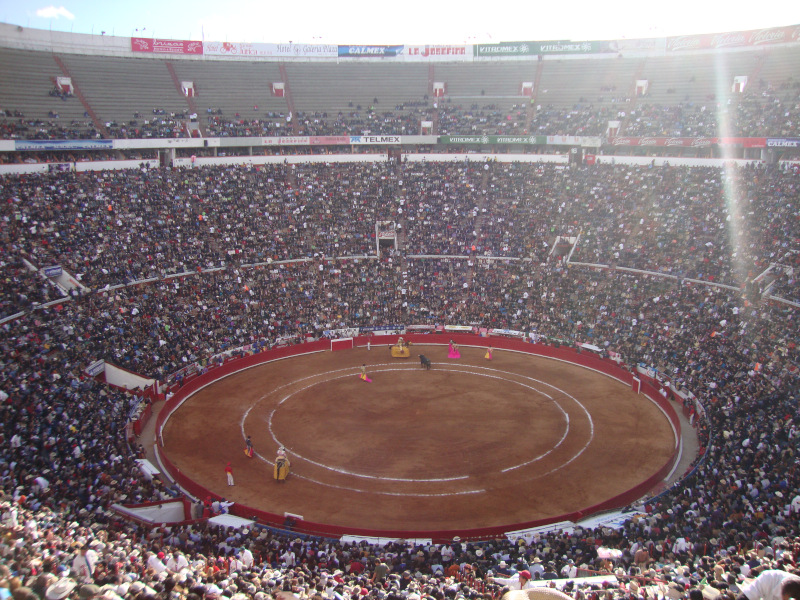
La Plaza de Toros, Mexico City
***
I know. I know. I can hear your objections. But which type of bull would you prefer to be, a regular bull or a fighting bull?
A regular bull lives to the age of eight months, when it's carted off and rather cruelly killed in the slaughterhouse. It has a dull life, eating mediocre food, spending most of its time in a small pen, with very little exercise, without even the freedom to lie down with its legs extended.
On the other hand, a fighting bull is treated royally, fed an excellent diet, exercised regularly, allowed free range in large fields, used for breeding, and by law isn't allowed to fight until he is at least four years old. So he lives a rather pleasant, longer life.
I'd certainly prefer to be a fighting bull.
A bullfight is divided into three stages, in which there are six bulls and three matadores. Each matador fights two bulls.
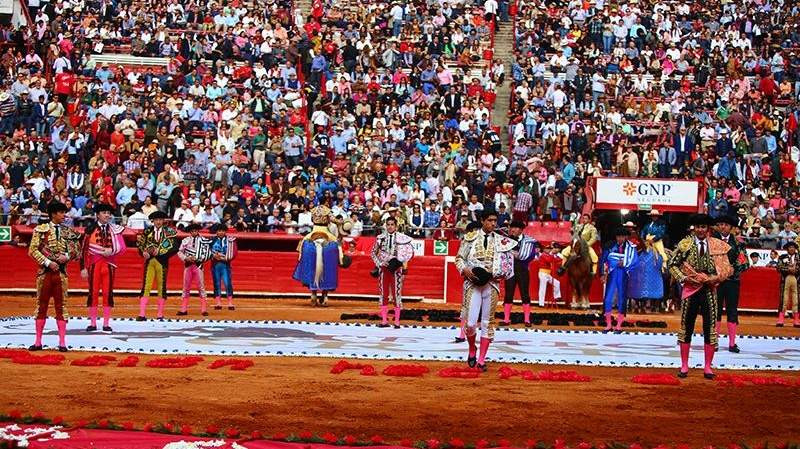
Matadores entering the ring
***
In the first stage or act, a picador comes into the ring mounted on a heavily padded, blindfolded horse. He jabs the bull with his lance in order to soften up his shoulder muscles so that he will charge at the matador with his head down, thus giving the matador a clear shot at a very small area in his shoulder. This area, where the matador aims to put his sword when he goes in for the final death blow, is very small — about the size of a quarter. The rest of the bull's shoulder area is solid bone. If the sword hits that bone, it will simply bounce back out. This first act is my least favorite stage of the bullfight. But the crowd will boo and complain loudly if the picadores do their job for too long or use excessive force. As well, the matador may request that his picador stop at any time.
In the second act, the matador's assistants, or toreadores, place banderillas — barbed sticks that are literally "little flags" as they are decorated with brightly colored ribbons — to mark out that very small area that is not bone. To do this, the toreadores must leap high in the air above the bull.

In the third act, the matador gets to perform and show his expertise in passing the bull with his small red cape and trying to bring his body as close as possible to the bull.

It's at this stage that the audience screams ¡ Ole! every time the matador completes a pass successfully; the more passes in a row, the better, and the more varieties of passes, the better. Mexicans love to encourage the matador to execute the best and most dangerous passes he is capable of doing.
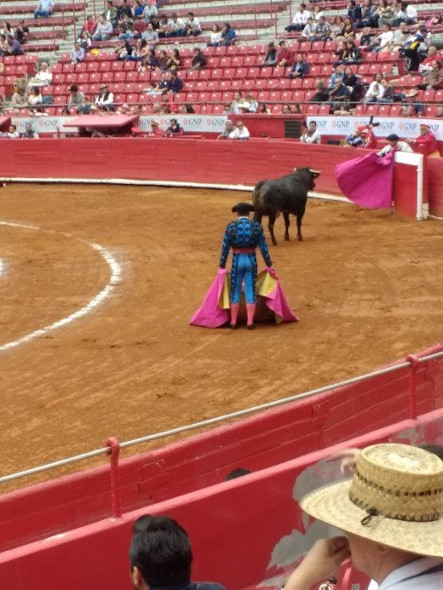
A good bullfighter will kill the bull quickly and efficiently. In that third act, he has no more than 20 minutes to kill the bull. If the bull isn't dead within 20 minutes, the crowd will complain and jeer loudly, urging the judge to order someone else to go in and quickly put a merciful end to the bull's life. Under those circumstances, the matador exits in total disgrace.
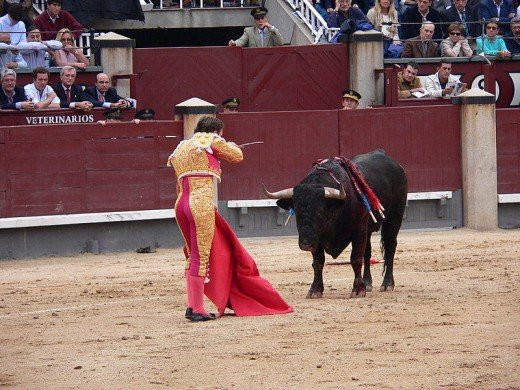
Matador going in for the kill
***
The crowd will also complain loudly if the matador is inept, thereby causing excessive cruelty to the bull. Many times I've heard the crowd cheering for the bull, which is a terrible insult to a matador. If one act goes on for too long, again the crowd will complain and the judge will signal the orchestra to play the music that begins the next act.
For me, the perfect ending of a bullfight is when the bull puts up a great fight and the crowd insists strongly that he be spared, put out to pasture, and used for breeding for the rest of his natural life. How's that for fairness? The bull actually has a chance to fight for his life and, if his life isn't spared, then he gets the chance to go out in a 25-minute blaze of glory at the age of four or five.
The Freudian explanation of a bullfight is that the bull represents the animal side of us; the matador represents the intelligent part of us; and the crowd represents our conscience.
Once, in the off-season, I attended a bullfight in a rural bullring with a tour group. (Bullfight season in La Plaza de Toros runs from October/November until March/April.) Most of the American tourists were not looking forward to seeing the "exhibition of cruelty." Still as the bullfight commenced, they were curious, puzzled by what was happening and asked a few questions. I answered them based on my research and experience.
After the bullfight, we returned to Mexico City. When the guides had dropped everybody but me off at their hotels, I began to worry. One of them put my worries to rest by saying, "We want to take you out to dinner and ask you some questions. Please come to dinner with us." During our dinner they took out notebooks and pens to take notes explaining, "That's the first time ever that we've taken tourists to a bullfight when they didn't all demand to leave after the first or second bull. These tourists today stayed to the very end of the fight and weren't grossed out at all. What in the world did you tell them?" After I shared some of my research on bullfights, they refunded my money and made a standing offer, "Any time you're in Mexico City and you want to go to a bullfight, you can come with us for free." The reason that I mention this incident is because I've always thought this experience proves that if you do your research and understand what's going on, then bullfights don't appear cruel or detestable at all.

I attended a Sunday bullfight in a small town near Cholula where Joselito Huerta was fighting. At the time Joselito was the most favored matador at in all of Mexico. He was a world-famous athlete, an artist in the ring. When I returned to work on Monday at the university, all my Mexican co-workers asked me how the bullfight had gone. I replied in my Spanish of the time, "It was wonderful! They awarded Joselito two ear canals and a broom." My co-workers didn't want to be rude, but they couldn't contain their laughter at my warped Spanish. One of them put his head down on his desk. All I could see were his shoulders shaking because he was laughing silently. When they corrected my Spanish, I learned that the word for earflap is oreja and the word for tail is cola, which, of course, is what I had meant to say. The tradition of awarding ears and tails for an exceptionally good performance has been handed down from the time when the matadores needed those parts for a good meal.
I've seen bulls spared because of their bravery, and I've also seen matadores killed by bulls. So not all the odds are totally stacked against the bulls.
Some critics argue that bullfighting is wrong because it is killing for fun rather than for food. But the fact that there is a butcher shop located in the bullring has always impressed me. There the meat is immediately cut up and donated to orphanages.
Bullfighting serves human nutritional needs. Many more bulls are killed in abattoirs than die in the bullring. It is an indisputable fact that the conditions of industrial slaughterhouses are much worse than the conditions in the bullring during corridas. To protest bullfighting while continuing to eat veal from calves who have been deprived of their mothers, have been given a bad diet all their lives, have been corralled in a prison, and who have then been killed in a slaughterhouse in the cruelest possible way is hypocritical to say the least. The same applies to eating eggs from hens who have spent their lives crammed into cages or eating the hens themselves.
The word "bullfight" is an unfortunate English translation for what is called "toreo" or"corrida de toros" or "fiesta brava" in Spanish. The word "bullfight" comes from the artless, reckless, brutal hobby of bull-baiting that existed in England and Spain. Ever wonder where English bulldogs got their name? In England people used to throw bulldogs into the bullring and then take bets on whether the bulldog or the bull would survive.
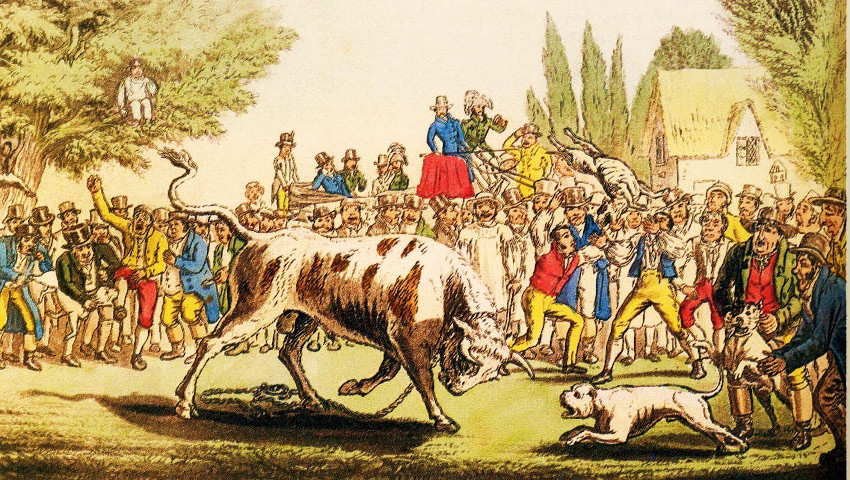
Numerous peoples throughout the world have at one point in time honored bulls as sacred. The sacred bull survives in the constellation Taurus. Bulls are depicted in many European cave paintings such as those found at Lascaux, France. Early carvings of bulls have also been found. Their life force was thought to have magical qualities. The matador must carry himself in the bullring with grace. The way he moves the bull reveals, slowly and artistically, the inherent strength and beauty of the bull.
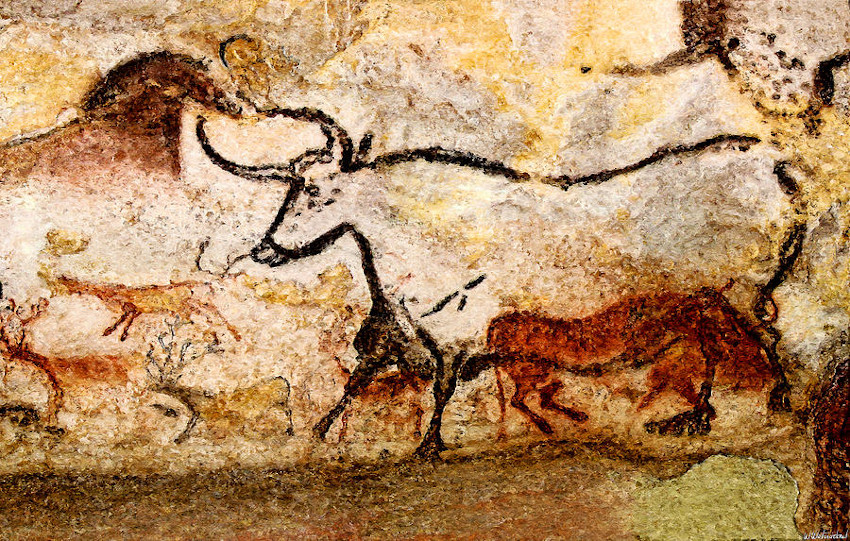
Lascaux Hall of the Bulls
***
When I hear foreigners say that bullfighting is a "blood sport," I reply, "First of all, the bullfight is not a sport. It's an artistic ritual that's embedded in Latin culture. It's not really cruel." Then, explaining the differences between a regular bull and a fighting bull, I ask them which type of bull they would prefer to be. I receive lots of frowning disapproval. Still, I contend you need to do your research and be there before registering your complaints.
**************

Pat Hall is a retired Canadian who has been visiting San Miguel for the past 22 years. Many years ago Pat worked in the library at the Universidad de las Américas in Cholula, Puebla for three years where she also studied Spanish. In Canada she worked as a librarian, library science instructor, and language teacher (French, Spanish, German, Latin, and English as a Second Language). The last 10 years of her working life were spent as a translator, translating official documents. She has recently published a book, Speak To Me: Travels and Exploits of a Language Lover, available on Amazon, about her adventures traveling and pursuing her passion for languages.
